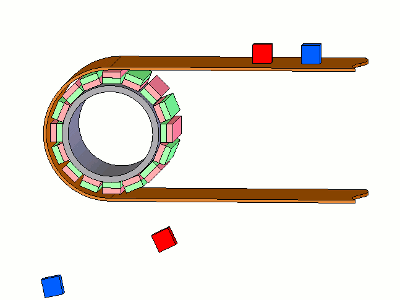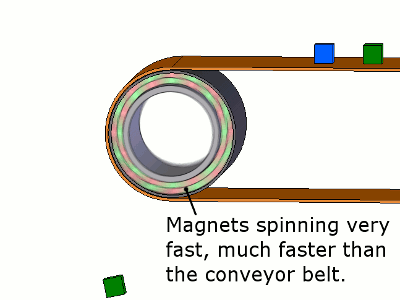Last month, we wrote about how magnets are assembled for magnetic separation applications – attracting iron, steel, or other ferromagnetic bits to get contaminants out of other materials. It was a great example of some specific ways that magnets are selected and assembled for this task.
Still, some of you might be thinking, “Big deal, iron sticks to magnets. We knew that.” We have to agree that’s true.
What if there was a way to use magnets to separate metals that are NOT attracted to magnets? If we could separate aluminum cans (which magnets don’t stick to) from other, non-metallic trash, would that be amazing?
Read on to learn more about how this is really done!

This demonstration is fairly straightforward. We constructed a conveyor belt that has a roller covered with magnets. The magnets are arranged with alternating poles facing out, which provides a strong magnetic hold.
The results are pretty much what you would expect. The stuff that is not attracted to magnets just falls straight down. The ferromagnetic bits that are attracted to magnets stay stuck to the conveyor belt a little longer, and are dropped a bit further back.
With strategic placement of a separating wall, this kind of setup can separate ferromagnetic materials like iron, nickel or steel from other materials, such as ore, waste, etc.
Magnets do not stick to aluminum or copper, nor to many other electrically conductive metals. How can magnets help separate these materials from other stuff?
The answer lies with Eddy Currents. If you move a magnet near a piece of conductive metal, the moving magnetic field induces currents in the metal. The spinning currents act like little magnets, making a repelling force between the magnet and the metal.
In that earlier article, we showed a few classic demonstrations of this phenomenon, such as a magnet falling slowly through a tube or sliding slowly down an aluminum surface. If we have enough magnetic field strength and relative speed between the magnets and the metal, the magnets exert a force on the metal.
For a demonstration, we'll use another conveyor belt arrangement. The key to eddy current separation is to get the magnets moving much faster than the material on the conveyor belt. We need to get the magnets moving a lot faster than the stuff we’re separating.

We put a stationary tube around the spinning magnets, and slid a conveyor belt slowly over it. Inside the tube, we spin the magnets around at great speed. The quickly moving and changing magnetic fields provide a force in bits of aluminum thanks to eddy currents. This gives these materials an extra nudge off the conveyor belt, throwing them off rather than just dropping them.
Watch how these rapidly moving magnetic fields give the conductive metals a slight push off the conveyor belt!
That’s really a general question looking for a specific answer. It depends! The magnets you choose depend on a wide number of variables, including the design of your machine, conveyor belt, desired strength, distance from the magnets to the materials, etc.
We used some BX884DCS magnets for our iron separator. Our Countersunk Magnets are popular for this sort of thing, since they are easy to assemble. Most of the actual, industrial separators we’ve seen use much larger magnets like the 2" x 1" x 1/2" thick BY0X08DCS. We chose smaller ones because it was simpler for our scaled-down model.
We used 2" x 3/8" x 1/4" thick BY064 plain blocks for the Eddy Current Separator shown in the second video. It was a good size for our scale, and they worked well. We actually chose these specific magnets because we had a small stack set aside that had scratched plating. Other similar block magnet sizes would have worked as well.